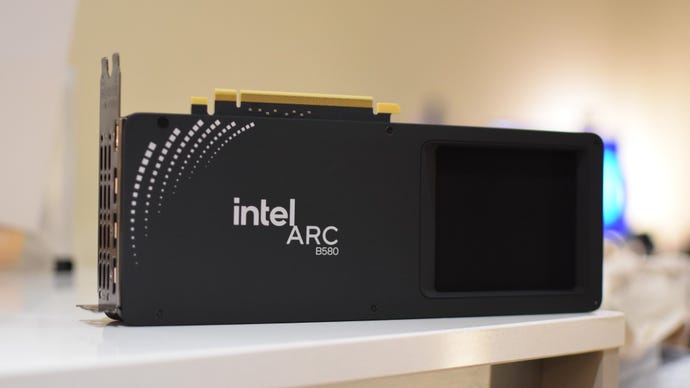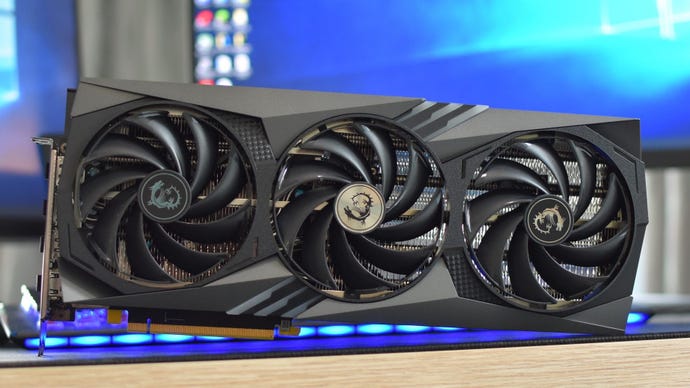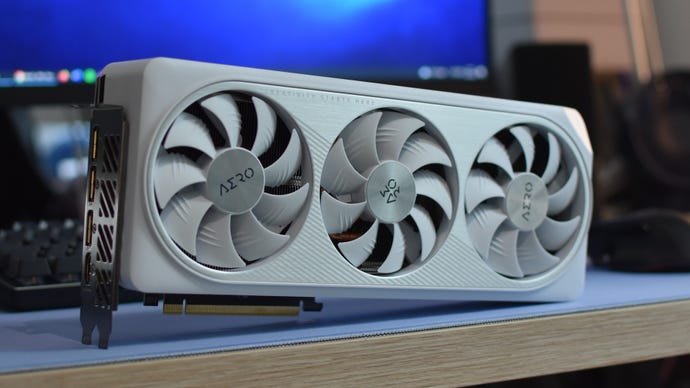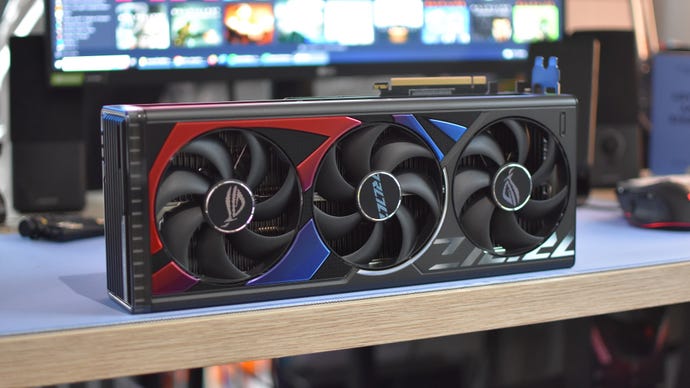Best graphics cards: the top gaming GPUs
Our top graphics card picks for 1080p, 1440p, and 4K
New year, new best graphics card contenders. Understandably, all eyes are currently on Nvidia’s RTX 50 series, which spans the mid-range RTX 5070 all the way up to the RTX 5090 and its apparently-not-a-joke $1999 price tag. They’ll be launching from January 30th onwards, but in the meantime, let’s not forget the much more budget-friendly Intel Arc B580, which has what it takes to knock the RTX 4060 off its 1080p perch.
Truth be told, Nvidia could do with some more spirited competition, especially since they’ve gone all-in on pitching their GPUs on their features as much as their core performance. Chief among these is DLSS, their best-in-class upscaler, as well as the frame generation trickery of DLSS 3 – and now DLSS 4 as well, courtesy of the RTX 50 series. AMD have seriously struggled to keep up, their FSR 3 proving an unreliable equivalent, though the Arc B580 does put in a good showing with Intel XeSS 2. It also suggests that Intel are catching up with the GeForce range on ray tracing performance, another RTX strong suit.
In short, there’s a lot more to take into account when picking the "best" GPUs than just how they run on regularly rendered, non-upscaled games. Hence why they all get thoroughly tested in a variety of benchmarks, and at different resolutions, so you can be sure that the one you pick is the best possible fit for your PC setup.
Whether you should buy right now is a different matter – at least for those in the market for a higher-end model, I’d wait to see how the RTX 50 series (and perhaps AMD’s Radeon RX 9070 GPUs) turn out. If, though you do absolutely need a graphics card right this second – who knows, maybe you just want to build a tower out of them – then these are the best of the currently available bunch.
The best graphics cards for gaming
- Intel Arc B580 - the best 1080p graphics card
- Nvidia GeForce RTX 4060 Ti - the best 1440p graphics card
- Nvidia RTX 4070 Super - the best graphics card for ultrawide gaming monitors
- Nvidia GeForce RTX 4080 Super - the best graphics card for 4K
Intel Arc B580
The best 1080p graphics card

I had to deliberate for a while whether the RTX 4060 should remain our top 1080p pick, or whether Intel Arc B580 was a deserving replacement. The RTX 4060, after all, offers DLSS 3 – a far more widely-supported upscaler/frame generation tool than the B580’s XeSS 2. When I tested on an older CPU, they also performed nearly identically, perhaps with a slight advantage to the 4060.
However, when paired with a more up-to-date processor, the Arc B580 made better use, outrunning the RTX 4060 with much more regularity and sometimes by 10fps or more. 1080p might be the least demanding of the common gaming monitor resolutions, but provided your CPU is fairly recent, the Arc B580 does seem readier to handle max-quality gaming. Don’t be put off by the Intel card’s higher power requirements either: in practice, I found it usually draws within the 110-115W range, same as the RTX 4060.
The Arc B580’s Battlemage architecture also seems like a general improvement over Alchemist, the basis of cards like the Arc A750. Besides being more stable (i.e. less crash-prone), it also manages these performance feats straight out the box – not after months of driver updates, like Alchemist needed.
Read more in our Intel Arc B580 review
Nvidia GeForce RTX 4060 Ti
The best 1440p graphics card

For a Quad HD-tuned PC, there’s a tough call to make between the AMD Radeon RX 7700 XT and this, the 8GB version of the Nvidia GeForce RTX 4060 Ti. The Radeon is faster in non-ray-traced, native rez games, and offers more VRAM, packing 12GB.
I’d still go for the RTX 4060 Ti, though, because it overturns its performance disadvantage once you start making use of all its toys. DLSS upscaling looks nicer than FSR’s, but there’s also the RTX 4060 Ti’s drastically superior ray tracing performance, and the possibility of enabling DLSS 3 to send framerates soaring.
Even standard DLSS upscaling can be enough to spin things in the RTX 4060 Ti’s favour. In Cyberpunk 2077, it could average 46fps at 1440p with maxed settings, Psycho ray tracing, and DLSS on Quality; the RX 7700 XT could only manage 38fps using Quality FSR.
Read more in our Nvidia GeForce RTX 4060 Ti review
Nvidia RTX 4070 Super
The best graphics card for ultrawide gaming monitors

The Nvidia GeForce RTX 4070 Super is a surprisingly potent upgrade on the original RTX 4070, gaining a marked performance uplift (especially at higher resolutions) without raising the price. You could even use it for some decent 4K, but it’s excellent for ultrawide resolutions as well. With ray tracing or upscaling, it’s either level with or slightly faster than the AMD Radeon RX 7800 XT on speed, and beats it outright whenever RT effects or DLSS upscaling are in play.
That alone is enough to take the 7800 XT’s spot in this list, but the RTX 4070 Super also supports DLSS 3, which enjoys compatibility with a much wider selection of games than AMD’s FSR 3. And even if it didn’t, FSR 3 works on Nvidia cards anyway, so the RTX 4070 Super loses out on nothing.
Read more in our Nvidia GeForce RTX 4070 Super review
Nvidia GeForce RTX 4080 Super
The best graphics card for 4K

Maybe a slightly contentious pick here – my Nvidia GeForce RTX 4080 Super review wasn’t especially glowing. But that was mainly down to its lack of a clear performance upgrade over the RTX 4080, in contrast to the RTX 4070 Super’s improved FPS-slinging.
It’s true that I wish the RTX 4080 Super took a bigger leap forward, but it does beat the RTX 4080 on price, despite being the newer, quicker version. That’s a big deal, as the biggest issue with the previous GPU was its unreasonable outlay. 4K performance was never a problem in itself, and the RTX 4080 Super maintains that ability to run max-quality, optionally ray-traced games at a fast clip. Factor in the lower cost, and its status as the best graphics card for 4K is the result of a simple numbers game.
(There’s also the RTX 4090, of course, but I don’t recommend that unless you’re a shipping magnate or are no more than fifth in line to a throne.)
Read more in our Nvidia GeForce RTX 4080 Super review
Frequently asked questions
Why are some graphics cards so expensive?Remember how in 2020-21, it was basically impossible to buy a new graphics card before some bot-wielding scalper cretin pinched all the stock? And how all that demand led to retailers jacking their prices up severalfold? All of that has largely calmed down now, but graphics card still trend more expensively they did before that miserable period. Manufacturers attribute this to higher research and manufacturing costs, though considering the likes of the RTX 30 series sold out instantly despite massive inflation, it’s very possible that sellers saw how much people are willing to pay for new GPUs and simply continue to take advantage.
Which graphics cards have ray tracing?Ray tracing can be a huge upgrade to how your games handle lighting, shadows and reflections, but you need compatible GPU to take advantage of it. Right now, that includes all of Nvidia's RTX GPUs, from the 20 series to the 50 series, as well as of AMD's desktop-grade Radeon GPUs from the RX 6000 series onwards. Intel's Arc graphics cards support ray tracing as well.
Which is better, AMD or Nvidia?An age old question, the answer to which seemingly used to change with every generation of new GPUs. Recently, however, Nvidia have dominated, despite AMD Radeon GPUs sometimes matching them on rasterised performance and often beating them on price. Nonetheless, the RTX range’s vastly superior ray tracing capabilities, as well as their support for DLSS (and more recently, DLSS 3 frame generation) typically makes the investment easier to justify.
AMD have produced their own versions of these features, such as frame gen-capable FSR 3, but they’re seldom as impressive as the Nvidia equivalents. Besides, FSR is available to all GPUs, not just AMD’s, so it never feels like you’re missing out on features by buying an Nvidia model.

